|
 THE
PROTECTION OF CULTURAL HERITAGE SITES FROM NATURAL AND MAN-MADE
DISASTERS
George
Pararas-Carayannis
THE
PROTECTION OF CULTURAL HERITAGE SITES FROM NATURAL AND MAN-MADE
DISASTERS
George
Pararas-Carayannis
Excerpts
from paper published in the Proceedings of the Geological and
Geotechnical Influences in the Preservation of Historical and
Cultural Heritage
GeoBen2000 - Moncalieri Castle, Stupinigi Castle- Torino, Italy
7-8-9 June 2000
©
2000 George Pararas-Carayannis
/ all rights
reserved

ABSTRACT
Natural hazards continue
to pose a significant threat to mankind in the new millennium
in spite of international efforts to mitigate their effects through
warning systems and international cooperation in disaster preparedness
established through programs such as the International Decade
on Natural Disaster Reduction (IDNDR) in the last decade of the
20th Century. The momentum of worldwide efforts in hazard mitigation
continues to grow, with the major emphasis being placed in the
protection of life and property. To the toll of natural hazards,
we must now add the toll of man-made hazards, such as pollution
of the atmosphere and of the seas, climatic changes, and the
effects of industrial accidents, civil strife and wars.
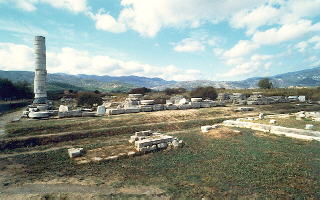 Although commitments have been
made to study hazards better and to apply techniques that will
reduce mankind's overall vulnerability, very little effort has
gone into the protection of threatened sites around the world
where monuments of historical, archaeological, ethnological or
anthropological value exist. Such sites are important because
they represent masterpieces of the human creative genius, bearing
testimony to cultural traditions of past civilizations and illustrating
prominent stages in human history with artistic works of outstanding
universal significance. These are sites which need protection
from the effects of all hazards because of their importance in
mankind's cultural heritage and evolution - a legacy from the
past which must be preserved for future generations as they are
irreplaceable sources of inspiration and points of reference
to human identity, intelligence and civilization. As such, these
world heritage sites represent resources of outstanding universal
value, which belong to all the peoples of the world, regardless
of the territory on which they are located and national sovereignty
or ownership. Although commitments have been
made to study hazards better and to apply techniques that will
reduce mankind's overall vulnerability, very little effort has
gone into the protection of threatened sites around the world
where monuments of historical, archaeological, ethnological or
anthropological value exist. Such sites are important because
they represent masterpieces of the human creative genius, bearing
testimony to cultural traditions of past civilizations and illustrating
prominent stages in human history with artistic works of outstanding
universal significance. These are sites which need protection
from the effects of all hazards because of their importance in
mankind's cultural heritage and evolution - a legacy from the
past which must be preserved for future generations as they are
irreplaceable sources of inspiration and points of reference
to human identity, intelligence and civilization. As such, these
world heritage sites represent resources of outstanding universal
value, which belong to all the peoples of the world, regardless
of the territory on which they are located and national sovereignty
or ownership.
Cultural Heritage
Site: Heraion, Samos Island, Greece
It is the duty of
the international community as a whole, and the international
scientific community in particular, to protect the integrity
of such cultural heritage sites from the destructive effects
of natural and man-made hazards. Already some sites with recognized
cultural value have deteriorated, or have been partly destroyed,
or are in imminent danger due to the effects of such diverse
disasters as earthquakes, volcanic eruptions, floods, land subsidence,
pollution, acid rains or the outbreak of civil strife and wars.
The present paper identifies some of the outstanding cultural
sites in the Mediterranean Basin, analyzes hazard risks for these
sites and outlines a global strategy and a plan of action on
expanding international scientific cooperation among technical
experts in disaster mitigation to include the protection and
conservation of threatened cultural sites in critical areas of
the world.

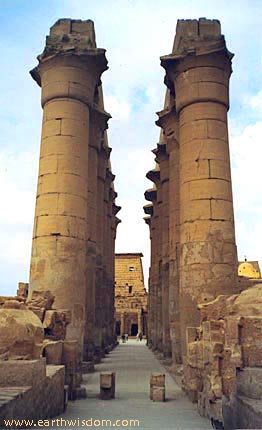 INTRODUCTION INTRODUCTION
The deterioration
or destruction of cultural heritage sites constitutes a harmful
loss to humanity as such sites represent unique and irreplaceable
properties of great value to mankind's legacy. In 1972, recognizing
the importance and need to safeguard these sites from a variety
of hazards, the United Nations Education, Scientific and Cultural
Organization (UNESCO) held a World Heritage Convention. The Convention
identified that the threat of destruction of cultural heritage
sites included not only the traditional causes of weathering
and aging decay, but also changing social and economic conditions
around the world. Since 1972, the Convention established a very
successful international program with the participation of 132
member nations. In the last three decades, and as a result of
this coordinated international effort, hundreds of cultural heritage
sites around the world were selected, protected, restored and,
in many cases, saved from total destruction.
Egypt: Luxor Colon
Amenophis
Although remarkable progress has been made, the focus of the
international program has been placed primarily on the impact
of rapidly changing social and economic conditions and to a much
lesser extent on mitigating the effects of existing environmental
dangers or on assessing the threat of future natural and man-made
hazards on cultural heritage sites. Many of these heritage sites
around the world remain vulnerable to the adverse impacts of
pollution, earthquakes, volcanic eruptions, tsunamis, landslides,
floods, changes in water level, serious fires, armed conflicts
and multitudes of other disasters. The increasing scope and importance
of the Convention makes it imperative now that a new international
organization be established to address specifically these threats
to cultural heritage sites. Such organization could bring together
teams of international experts with the necessary qualifications
in the earth, environmental and geotechnical sciences with their
counterparts in archaeology, history and culture. Converging
the talents and contributory inputs of such diverse group of
experts into a strategically organized group under a new and
more specialized organization, would make it easier and more
effective to address some of the unique problems related to the
preservation and protection of cultural heritage sites from natural
and man made hazards. Furthermore, the proposed organization
would augment and complement greatly the goals and objectives
of the Convention.
To illustrate the above stated need for action by the international
scientific community, the present paper provides a brief overview
of the dangers that natural and man-made hazards present to cultural
heritage sites by summarizing some the past, present and potential
future impacts. Then, it provides a few examples of adverse impacts
of hazards on a few select sites in the Mediterranean Region.
Finally, the paper : a) proposes the establishment of new specialized
organization that can focus on long term geotechnical planning
for the protection and preservation of cultural heritage sites
from adverse impacts of disasters; b) outlines preliminary goals
and objectives for such organization; and c) recommends that
UNESCO declares the next decade of the new millennium to be an
International Decade for the Protection of Cultural Heritage
Sites from Disasters (IDPCHSD)

THE
THREAT OF NATURAL AND MAN-MADE DISASTERS TO HUMANITY AND ITS
CULTURAL HERITAGE SITES
Major natural and
man-made disasters have always created havoc and destruction
all over the planet. Weather-related natural disasters such as
hurricanes, tornadoes, heavy thunder, storms, flooding, mud/rock
slides, high winds, hail, severe winter weather, avalanches,
extreme high heat, droughts, wildfires have taken a great toll
on humanity. Similarly destructive have been the non weather-related
natural disasters, such as earthquakes, volcanic eruptions, and
tsunamis. In recent years earthquakes have caused destruction
and claimed thousands of human lives throughout the world. The
percentage of earthquakes causing 1,000 + fatalities has increased
by 10% causing approximately 1.4 million deaths since 1910.
Man-made hazards have also taken a heavy toll. Continuous population
growth has disturbed the delicate balance between ecosystems
on our planet. There is pollution of the atmosphere and of the
seas, destruction of the rain forests, fires burning out of control,
alterations of sensitive ecosystems, destruction of the ozone
layer, climatic changes not fully comprehended. Chemical spills
have polluted rivers and watersheds. Toxic material emissions,
civil strife, wars and acts of terrorism present now the greater
dangers for mankind. Since 1945, civil strife and wars around
the world have killed more than 20 million people in 150 regional
conflicts alone. A research group of the National Defense Council
Foundation, cited 70 armed conflicts in 1994, up from 62 in 1993.
The trend is clear, armed conflicts and complex man-made disasters,
are increasing in frequency and severity in various parts of
the world.
Natural and man-made hazards not only have caused losses of hundreds
of thousands of human lives but have also adversely affected
many important cultural heritage sites around the world by causing
deterioration, partial damage, total destruction or the loss
of cultural value. Natural and man-made disasters represent a
real potential threat for these sites in the future.

EXAMPLES
OF ADVERSE IMPACT OF NATURAL AND MAN-MADE DISASTERS
The impact of natural
and made-made disasters on cultural heritage sites around the
world, has been extensive. The following examples summarize and
illustrate the diversity of adverse impacts on a few select sites
in the Mediterranean Region.
Impact of
Armed Conflict on World Heritage Sites in the Republic of Croatia 
In 1991 and 1992, the World Heritage sites of Dubrovnik, Plitvice
and Split suffered damage as a result of armed conflict in the
area. According to the World Heritage Center, the ancient city
of Dubrovnik was subjected to artillery bombardment and 563 civil
and religious buildings (70 per cent of the total) were hit by
some 2,000 shells and 9 buildings (7 palaces and 2 houses) were
totally destroyed by fire while the roofs of 4 others were partially
burned. Cultural heritage sites in the Republics of Croatia and
Slovania continue to be in peril by the threat of future conflict
in the region.

Croatia, Dubrovnic
-Lovri jenac

The Effects
of the 12 October 1992 Earthquake on World Heritage Sites in
Egypt
Cultural Heritage
Site: Luxor, Egypt; Court of Amenophis
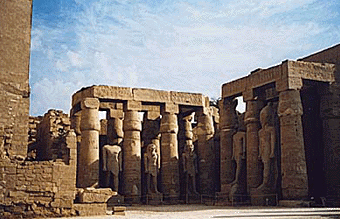 On
12 October 1992, an earthquake in Egypt caused severe damage
to a number of cultural heritage sites including some 150 Pharaonic,
Coptic and Islamic monuments. Apart from a few cracks, the Temple
of Luxor was spared from destruction. However to what extent
the earthquake weakened the structure is not known. At Kom Ombo,
earthquake ground motions were so severe as to dislodge and drop
to the ground two large blocks, each weighing ten tons. Prior
assessment and structural reinforcement could have prevented
this damage. The Cheops and Sakkarah pyramids lost some stones
and the surface of the Chephren pyramid suffered some fissuring.
Other Pharaonic monuments were similarly affected. On
12 October 1992, an earthquake in Egypt caused severe damage
to a number of cultural heritage sites including some 150 Pharaonic,
Coptic and Islamic monuments. Apart from a few cracks, the Temple
of Luxor was spared from destruction. However to what extent
the earthquake weakened the structure is not known. At Kom Ombo,
earthquake ground motions were so severe as to dislodge and drop
to the ground two large blocks, each weighing ten tons. Prior
assessment and structural reinforcement could have prevented
this damage. The Cheops and Sakkarah pyramids lost some stones
and the surface of the Chephren pyramid suffered some fissuring.
Other Pharaonic monuments were similarly affected.
Cultural Heritage
Site: Luxor, Egypt; Temple of Philae
The World Heritage
Center reported that elsewhere in the region, the Coptic and,
especially, the Islamic monuments suffered the greatest damage.
According to surveys, the Blue Mosque and the Al-Hussein Mosque
suffered serious fissuring and the vault of the Tachtuchi Mosque
collapsed. The minarets of several other mosques were weakened,
becoming detached from the main structure of their mosques. All
these mosques were affected by atypical vertical fissuring. Fissuring
and the dislodgement of stones occurred also at Al Azhar, Ibn
Touloun, Al Ghouri, the mausoleum of Quayt Bey and the recently
restored Bichtaq palace. A number of churches in the Coptic quarter,
notably the Suspended Church of Al Moallaqah, also suffered similar
damage. It is not known to what extent the structures were weakened
by this earthquake or what the next event will do..

Effects
of Civil Strife and Neglect on the Cultural Heritage Site of
Butrint, Albania
Cultural Heritage
Site: Butrint, Albania: Germadha
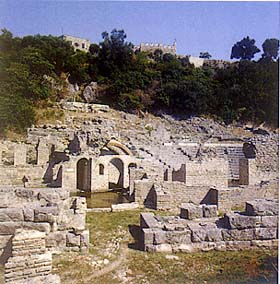 Many
cultural heritage sites in Albania are threatened by man-made
and natural hazards. The cultural heritage site of Butrint in
Albania, is an example. Butrint has been the site of a Greek
colony, a Roman city, and a bishopric. The site was inhabited
since prehistoric times. Subsequently, Butrint was under Byzantine
administration, then after a brief occupation by the Venetians.
The city was abandoned in the late Middle Ages after marshes
formed in the area. The present archaeological site is a repository
of the ruins representing each period in the city's development.
Recent threats to Butrint included the impact of civil disturbances
in the country in early 1997 and the looting of the site museum
during these civil disturbances. The site continues to be in
peril by the threat of conflict in the region, as well as to
the potential impact of natural hazards, such as earthquakes. Many
cultural heritage sites in Albania are threatened by man-made
and natural hazards. The cultural heritage site of Butrint in
Albania, is an example. Butrint has been the site of a Greek
colony, a Roman city, and a bishopric. The site was inhabited
since prehistoric times. Subsequently, Butrint was under Byzantine
administration, then after a brief occupation by the Venetians.
The city was abandoned in the late Middle Ages after marshes
formed in the area. The present archaeological site is a repository
of the ruins representing each period in the city's development.
Recent threats to Butrint included the impact of civil disturbances
in the country in early 1997 and the looting of the site museum
during these civil disturbances. The site continues to be in
peril by the threat of conflict in the region, as well as to
the potential impact of natural hazards, such as earthquakes.
Cultural Heritage
Site: Butrinti, Albania: by Petri
Omer
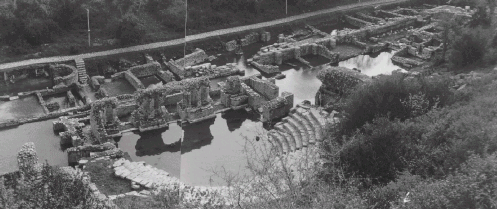

Threats
to Cultural Heritage Sites in the Old City of Jerusalem
The Old City of Jerusalem
represents exceptional value and unique religious and 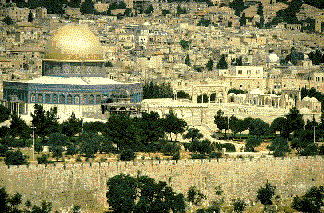 cultural significance for humanity.
This site is threatened by serious dangers and specific destruction
of religious properties due to urban development plans, deterioration
of monuments due to lack of maintenance and responsible management,
as well as by the disastrous impact of tourism on the protection
of the monuments. To the dangers, those related to civil strife
must be added. cultural significance for humanity.
This site is threatened by serious dangers and specific destruction
of religious properties due to urban development plans, deterioration
of monuments due to lack of maintenance and responsible management,
as well as by the disastrous impact of tourism on the protection
of the monuments. To the dangers, those related to civil strife
must be added.
Cultural Heritage
Site: Walls of Jerusalem
 Among Jerousalem's 220 monuments
identified by the World Heritage Center, threatened are the walls
of the period of Herod the Great, the enormous vaulted substructures
now known as the Stables of Solomon, the portal of a Roman colony
known as Aelia Capitolina, the rare vestiges of the triumphal
arches erected by Emperor Hadrian and the Jewish synagogues of
Ramban, Ben Zakkai, Stamboulli and Elijah the Prophet. Among Jerousalem's 220 monuments
identified by the World Heritage Center, threatened are the walls
of the period of Herod the Great, the enormous vaulted substructures
now known as the Stables of Solomon, the portal of a Roman colony
known as Aelia Capitolina, the rare vestiges of the triumphal
arches erected by Emperor Hadrian and the Jewish synagogues of
Ramban, Ben Zakkai, Stamboulli and Elijah the Prophet.

Adverse
Impacts of Earthquakes and Other Disasters on Cultural Heritage
Sites in Greece 
Many archaeological,
cultural heritage sites in Greece have been impacted adversely
in the past by earthquakes and other disasters and have sustained
considerable damage. For example at Olympia, the birthplace of
the Olympic games, inspection of columns and collapsed buildings
indicates a constant directional pattern of structural failures
consistent with seismic faulting of past earthquakes.
Cultural Heritage
Site: Byzantine Monastery of Daphni
 As recently as September 9, 1999,
a 5.9 magnitude earthquake struck near the city of Athens and
the surrounding area causing considerable destruction and posing
an immense threat to hundreds of archaeological sites in the
area - sites of major importance to classical Greek archaeology
and to the understanding of the ancient Mediterranean world.
As a result of this earthquake, the archaeological site of the
Monastery of Daphni , located near the epicenter, suffered considerable
damage. Although no significant damage to other cultural sites
was reported, there has been no expert assessment of the effects
of the earthquake in weakening the structural integrity of the
numerous archaeological sites in the area. Many of these sites
located near seismically active faults continue to be threatened
by future events. Acid rain and air pollution are other hazards
that have accelerated the weathering processes and the deterioration
of hundreds of other cultural heritage sites in Greece. The Pythagoreion
and the Heraion of Samos are among them. Fortunately, the problem
has been recognized and protective efforts have been initiated
for many such sites. For example, the monuments of Asklepieion
at the archaeological site of Epidauros are being presently restored.
Also restoration continues at the Parthenon and other monuments
on the Acropolis. As recently as September 9, 1999,
a 5.9 magnitude earthquake struck near the city of Athens and
the surrounding area causing considerable destruction and posing
an immense threat to hundreds of archaeological sites in the
area - sites of major importance to classical Greek archaeology
and to the understanding of the ancient Mediterranean world.
As a result of this earthquake, the archaeological site of the
Monastery of Daphni , located near the epicenter, suffered considerable
damage. Although no significant damage to other cultural sites
was reported, there has been no expert assessment of the effects
of the earthquake in weakening the structural integrity of the
numerous archaeological sites in the area. Many of these sites
located near seismically active faults continue to be threatened
by future events. Acid rain and air pollution are other hazards
that have accelerated the weathering processes and the deterioration
of hundreds of other cultural heritage sites in Greece. The Pythagoreion
and the Heraion of Samos are among them. Fortunately, the problem
has been recognized and protective efforts have been initiated
for many such sites. For example, the monuments of Asklepieion
at the archaeological site of Epidauros are being presently restored.
Also restoration continues at the Parthenon and other monuments
on the Acropolis.
 
Ancient Knossos
on the Island of Crete

Adverse
Impacts of Natural Disasters on Cultural Heritage Sites in Italy
Italy is another
country with numerous sites of immense cultural significance
for mankind. In spite of continuous efforts, many of its cultural
sites continue to be threatened by natural catastrophes. For
example Gerace, in Southern Calabria, and many of its monuments,
cathedral, castle and monasteries, have been adversely affected
by frequent natural disasters in the past. Similarly, historical
cultural sites in the provinces of Siracusa and Ragusa, on the
southern portion of the province of Catania in Sicily, were damaged
in the past by frequent landslides and earthquakes in the area.
These sites are threatened presently by the potential recurrence
of such natural disasters.
 THE
NEED TO PROTECT CULTURAL HERITAGE SITES FROM NATURAL AND MAN-MADE
DISASTERS
THE
NEED TO PROTECT CULTURAL HERITAGE SITES FROM NATURAL AND MAN-MADE
DISASTERS
In spite of mitigation
efforts, losses due to natural and man-made disasters will continue
to increase because of our continuing population growth in vulnerable
areas such as coastal regions, flood plains, and seismically
active zones - the same areas where cultural heritage sites are
also located. More and more cultural heritage sites will be adversely
affected in the future. However, this does not have to be so.
Vulnerable cultural heritage sites can be and must be protected.
Advances in the science and technology on hazard mitigation can
now provide some means to reduce significantly future losses.
It is incumbent that the international scientific community understands
and assesses better the effects that natural and man made hazards
have on cultural heritage sites and finds, applies, or recommends
techniques that will reduce future vulnerability.
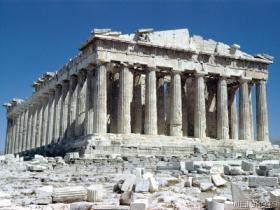 Concerted scientific and engineering efforts
must be made to assess the present state of cultural heritage
sites, their vulnerability to natural or man made hazards and
the feasibility of reducing future damages or destruction. For
example, if a cultural heritage site is found to be located near
a seismically active fault , anti-seismic retrofit measures can
be taken to protect it from the effects of future earthquakes.
Certain, man-made disasters, such as chemical spills or accidents,
can be prevented with proper regulation and supervision of industries
that cause them. Public awareness, community-based support and
governmental sponsorship to protect cultural heritage sites,
can be achieved through educational programs. Scientific research
can help identify better and more cost-effective, disaster mitigation
strategies for these sites. International efforts must continue
and put equal emphasis on scientific programs, engineering capabilities,
and in the national and international response to economic needs
to protect cultural heritage sites , particularly those in the
developing countries of the world. Although the scientific community
may be unable to do much about man-made hazards such as those
associated with war and civil strife, scientists as citizens
of this planet have the moral responsibility to raise the consciousness
of their governments to prevent armed conflicts from damaging
cultural heritage sites. Responsible government policies should
be aimed at preventing or mitigating the consequences of armed
conflicts on our environment. International treaties for the
protection of cultural heritage sites must be agreed upon. Concerted scientific and engineering efforts
must be made to assess the present state of cultural heritage
sites, their vulnerability to natural or man made hazards and
the feasibility of reducing future damages or destruction. For
example, if a cultural heritage site is found to be located near
a seismically active fault , anti-seismic retrofit measures can
be taken to protect it from the effects of future earthquakes.
Certain, man-made disasters, such as chemical spills or accidents,
can be prevented with proper regulation and supervision of industries
that cause them. Public awareness, community-based support and
governmental sponsorship to protect cultural heritage sites,
can be achieved through educational programs. Scientific research
can help identify better and more cost-effective, disaster mitigation
strategies for these sites. International efforts must continue
and put equal emphasis on scientific programs, engineering capabilities,
and in the national and international response to economic needs
to protect cultural heritage sites , particularly those in the
developing countries of the world. Although the scientific community
may be unable to do much about man-made hazards such as those
associated with war and civil strife, scientists as citizens
of this planet have the moral responsibility to raise the consciousness
of their governments to prevent armed conflicts from damaging
cultural heritage sites. Responsible government policies should
be aimed at preventing or mitigating the consequences of armed
conflicts on our environment. International treaties for the
protection of cultural heritage sites must be agreed upon.

ASSESSMENT
OF SERIOUS AND SPECIFIC DANGERS FROM MAN-MADE AND NATURAL DISASTERS
THREATENING CULTURAL HERITAGE SITES
Although there are
numerous natural and man-made disasters, fortunately only a few
of the major ones may affect adversely any particular cultural
heritage site. The vulnerability of each site will depend on
its geographical location, the regional environmental/geological
parameters and its present condition. In each case, a detailed
risk analysis must be undertaken to evaluate serious, specific,
ascertained and potential dangers threatening the site. Existing
or potential dangers from man-made and natural hazards are those
that threaten a cultural heritage site with severe deterioration,
damage, destruction, or other irreversible modifications. The
threat factors can be established by similar criteria of "ascertained"
and "potential" dangers, as those adopted by the World
Heritage Convention.
Ascertained Danger: For example, "ascertained
danger" would mean that a cultural heritage site is faced
with specific and proven imminent threat from a man-made or natural
hazard that would result in: a) serious deterioration of materials;
b) serious deterioration of structure and/or ornamental features;
d) serious deterioration of urban or rural space, or the natural
environment. In the case of ascertained danger, the physical
or cultural deteriorations to which a site has been subjected
should be judged according to the intensity of the hazard effects
and analyzed on a case by case basis.
Potential Dangers: "Potential danger"
would mean that the cultural heritage site is faced with major,
man-made or natural disaster threats which could have deleterious
effects on its inherent characteristics. For example, threats
from "potential danger" may include:
a) gradual changes
due to geological, climatic or other environmental factors;
b) an impending natural
disaster;
c) the outbreak or
threat of armed conflict;
d) threatening effects
of regional-planning projects;
e) Severe deterioration
as by human settlement, construction, industrial and agricultural
development including use of chemicals such as pesticides and
fertilizers, major public works, pollution, etc.;
f) Human encroachment
threatening a site's loss of cultural value or its physical integrity.
 Natural disasters of greatest potential threat
to cultural heritage sites would be earthquakes, volcanic eruptions,
landslides, floods, tsunamis, serious fires and changes in water
level. Above all in the case of assessing potential danger to
a cultural heritage site, one should consider that some threats
, such as demographic growth, are not imminent in nature but
can only be anticipated. Natural disasters of greatest potential threat
to cultural heritage sites would be earthquakes, volcanic eruptions,
landslides, floods, tsunamis, serious fires and changes in water
level. Above all in the case of assessing potential danger to
a cultural heritage site, one should consider that some threats
, such as demographic growth, are not imminent in nature but
can only be anticipated.
16th Century BC -
Royal Cemetery at Mycenae, Greece
Of the man-made disasters, armed conflict and civil strife pose
the greatest threat to the integrity of cultural heritage sites.
It may be often impossible to assess the potential threat of
armed conflicts or civil strife as to their effect on cultural
heritage sites. However, efforts could be coordinated so that,
if such conflicts erupt, there is an understanding that the integrity
of cultural heritage sites should be respected and protected.
Finally, another irreversible man-made hazard is the gradual
human encroachment upon a cultural heritage site. The proximity
of planned resettlement or development projects to a site presents
a great potential danger. Although less obvious, such human encroachment
can be serious threat that could significantly diminish a site's
cultural value.

.
ESTABLISHMENT
OF NEW ORGANIZATION OF GEOSCIENTISTS TO PROTECT CULTURAL HERITAGE
SITES
The increasing scope
and importance of the World Heritage Convention makes it imperative
that a new organization be established that can bring together
international experts for the purpose of focusing on long term
planning for the protection and preservation of cultural heritage
sites from the adverse impacts of man-made and natural disasters.
Teams of experts with the necessary qualifications in the earth,
environmental and geotechnical sciences, could collaborate closely
with experts in archaeology, history and culture to accomplish
the following mandate: 1) support national efforts towards safeguarding
the integrity of cultural heritage sites; 2) identify and demonstrate
the reality of serious and specific dangers of man made and natural
hazards threatening cultural heritage sites.
Specific
Goals and Objectives of the Proposed Organization
In view of the magnitude
and gravity of natural and man-made hazards threatening cultural
heritage sites, it is incumbent on the international scientific
community to participate in the protection of these sites by
rendering their collective assistance and expertise to action
programs in accordance to modern scientific methods and principles.
A new, specialized organization of geoscientists and geotechnologists
is proposed to work closely under the auspices of the World Heritage
Convention to augment and complement the Convention's goals and
objectives. The proposed organization would converge the talents
and contributory inputs of a diverse group of experts in the
earth sciences into a strategically organized association with
their counterparts in archaeology, history and culture. The new
Group would address the unique concerns of ascertained and potential
dangers stated above, as they relate specifically to the preservation
and protection of cultural heritage sites from natural and man
made hazards. The organization's primary responsibilities, goals
and objectives would be:
1. to promote the World Heritage Convention's objectives in the
protection of cultural heritage sites from the impact of man-made
and natural hazards;
2. to support national efforts towards safeguarding the integrity
of cultural heritage sites;
3. to identify "ascertained" and "potential"
dangers from natural and man-made hazards threatening cultural
heritage sites;
4. to evaluate the potential impact of hazards on specific cultural
heritage sites and conduct risk assessment analysis;
5. to ensure effective monitoring of sites for protection from
hazards;
6. to determine the means by which adverse impacts of natural
or man-made hazards could be alleviated or mitigated;
7. to conduct in situ surveys and identify the extent of damage,
if any, from such hazards soon after their occurrence;
8. to recommend to the World Heritage Committee, or UNESCO, the
means by which cultural heritage sites can be protected from
man-made and natural hazards;
9. to participate in the preparation and application of the decisions
and to arrange and supervise the financing of protection projects;
10. to coordinate with other groups and governmental and intergovernmental
authorities and organizations and to call on the support of the
various sectors of UNESCO, especially the culture and science
sectors and other associated consultative bodies.
 INTERNATIONAL
DECADE FOR THE PROTECTION OF CULTURAL HERITAGE SITES FROM NATURAL
AND MAN-MADE DISASTERS (IDPCHSD)
INTERNATIONAL
DECADE FOR THE PROTECTION OF CULTURAL HERITAGE SITES FROM NATURAL
AND MAN-MADE DISASTERS (IDPCHSD)
The United Nations
declared the decade 1990-2000 as the International Decade for
the Reduction of Natural Disasters (IDNDR). IDNDR has been a
very successful international program that contributed significantly
to mankind' s physical safety from the adverse impact of natural
disasters. A natural progression of the Decade's goal should
be to safeguard mankind's cultural heritage and legacy. It is
proposed that Congress 2000 drafts a resolution recommending
the first decade of the new millennium to be declared as the
International Decade for the Protection of Cultural Heritage
Sites from Disasters (IDPCHSD). Furthermore, it is proposed that
Congress 2000 forms a Working Group of Geoscientists to hold
a workshop for the purpose of identifying additional goals to
those suggested above and to promote the declaration by UNESCO
of a new Decade that will focus on the protection of cultural
heritage sites.

CONCLUSIONS
Presently, cultural
heritage sites around the world are inadequately protected from
rapidly changing social and economic conditions and even less
protected from the effects of existing and potential natural
and man-made hazards. Safeguarding these sites from such hazards
is extremely important as they represent unique and irreplaceable
properties of great value to the world's heritage. Although scientific
and technological resources to protect the sites exist, these
resources are not always properly utilized or coordinated. Considering
the magnitude and gravity of the dangers threatening the sites,
it is incumbent that the international scientific community participates
actively and collectively in their protection through an internationally
coordinated program similar to the IDNDR.
A first step, would
be a propitious, in-depth evaluation of the World Heritage Convention
actions for consideration of a future strategy in preserving
world heritage sites from the real threat of natural and man-made
disasters. The international scientific community can: a) develop
an interdisciplinary methodology to identify and evaluate risks
to the sites from both natural and man-made hazards; b) diffuse
existing knowledge on present and potential hazards; and c) recommend
the necessary measures that must be taken in each case.
It is proposed
that the United Nations declares a new international decade for
the conservation and protection of the world's heritage sites
from the effects of Natural and Man-Made Disasters (IDPCHSD).
 Return to
Return to

  Links to other
Pages
Links to other
Pages
 now available from Amazon, Barnes
and Noble and other major bookstores. It can be also ordered
by contacting directly Aston
Forbes Press.
now available from Amazon, Barnes
and Noble and other major bookstores. It can be also ordered
by contacting directly Aston
Forbes Press.

Now available
from Amazon, Barnes and Noble and other major bookstores. A signed
by the author copy can be also ordered by contacting directly
by email Aston
Forbes Press.
 Other
Miscellaneous Non-technical Writings
Other
Miscellaneous Non-technical Writings
 (©) Copyright
1963-2007 George Pararas-Carayannis / all rights reserved / Information
on this site is for viewing and personal information only - protected
by copyright. Any unauthorized use or reproduction of material
from this site without written permission is prohibited.
(©) Copyright
1963-2007 George Pararas-Carayannis / all rights reserved / Information
on this site is for viewing and personal information only - protected
by copyright. Any unauthorized use or reproduction of material
from this site without written permission is prohibited.
|